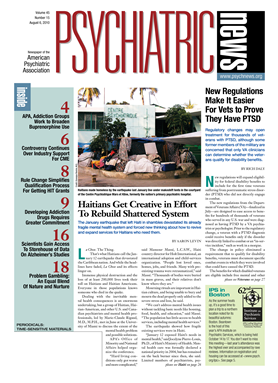While new medications are emerging to treat some substance use disorders, development of such treatments is lacking for most types of addiction. To overcome the significant cost disincentives and other barriers to new medical treatments for addiction disorders, mental health advocates are saying that it's time for a larger federal commitment.
Federal efforts to reduce illicit drug use in recent years have included stepped-up efforts to improving treatment for the most seriously addicted people. This subgroup of illicit drug users—estimated at up to 30 percent of the 20 million people in need of substance use treatment—drove 80 percent of the demand for highly addictive drugs.
But behavioral treatments, which are often used in this core group of seriously addicted drug users, have demonstrated only limited success. So some advocates maintain that more-effective and long-lasting recovery from drug abuse may lie in various types of pharmacological treatment, such as those already available for opioid addiction and alcohol dependence.
“Developing and using effective medications to treat addiction could make as big a difference in the individual lives of addicts as their widespread use could make in national drug-control policy,” said Rep. Dennis Kucinich (D-Ohio), at a hearing of a House Oversight and Government Reform subcommittee in June.
Several emerging medications and interventions for drug addiction are, however, providing hope that better treatments are on the horizon.
For example, although there are no approved medical treatments for cocaine or marijuana addiction, a combination of existing drugs (lofexidine and dronabinol) has reduced relapses in daily marijuana smokers in small studies. Another combination (naltrexone and buprenorphine) has shown efficacy in treating cocaine addiction, according to Nora Volkow, M.D., director of the National Institute on Drug Abuse.
She noted that other types of medications that could substantially increase long-term recovery from addiction include long-acting depot medications, vaccines, and individualized gene-based treatment.
“The possibilities, present in the knowledge we have accumulated, if translated into new medications today, could transform the way we treat addiction and even how we prevent drug abuse from occurring in the first place,” said Volkow in testimony at the hearing.
Obstacles to New Therapies Emerge
But numerous disincentives have resulted in pharmaceutical companies putting relatively little effort into the development of medical treatments for the full range of substance use disorders. Among the largest barriers to the creation of new drug therapies are financial obstacles, including the $2 billion average cost to bring a new drug to market, the high number of people with serious addiction disorders who have no health insurance, and the stigma that accompanies substance abuse.
“The reluctance of private companies to fully engage in the research and development of addiction medications has encumbered our ability to harness the full clinical potential of scientific discovery,” Volkow said.
This industry reluctance to conduct the needed research and development on medical treatments has resulted in the number of such treatments for addictive disorders growing minimally from only three in 1990 to five now. That small increase compares poorly with much greater growth in the number of HIV treatments, for instance, from one in 1990 to 20 now, said Jeffery Samet, M.D., in testimony on behalf of the American Society of Addiction Medicine.
“As a physician, having options when one good medication is not effective makes a big difference,” said Samet.
New Legal Requirements May Help
Recently enacted federal laws, such as the Patient Protection and Affordable Care Act and the mental health insurance parity requirement, may reduce some of those barriers to the development of medical addiction treatments. For instance, the national health care reform law should reduce the number of people with serious addictions who are uninsured and unable to pay for sometimes costly medical therapies, said A. Thomas McLellan, Ph.D., deputy director of the Office of National Drug Control Policy, at the June hearing. Also, the requirement that insurers offer equal coverage for mental health disorders—including substance use disorders—should reduce the stigma attached to treating such conditions.
“The recent health care legislation should improve coverage for, and access to, services for substance abuse disorders in the same primary care settings [that] now service all other illnesses,” said McLellan.
Federal efforts to spur the use of medical addiction treatments have included new Department of Justice grants to local criminal-justice programs that offer medication-assisted treatments in their jail-diversion programs for people arrested while buying illegal drugs.
Additional federal efforts are needed to spur private investment in the development of a larger number of medication treatments for substance use disorders, according to the head of one of the few companies that has commercialized such medications. Richard Pops, president and CEO of Alkermes Inc., told the subcommittee that the federal government needs to encourage and fund widespread use of available medication-based addiction treatments, which are now not widely used. Additionally, the federal government should commit to purchasing a specific amount of new medications that may eventually be developed as a way to encourage their research and production, similar to its approach to new vaccines.
“We believe that if the government exerts such leadership, then the promise of medication development will finally deliver for the millions of individuals and families affected by addiction,” Pops said.
